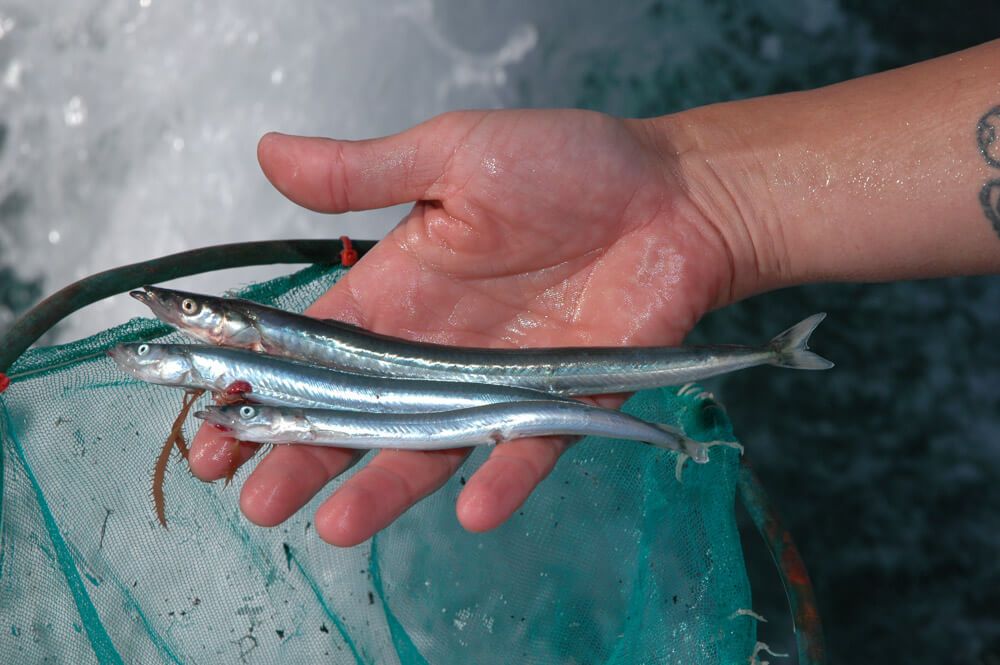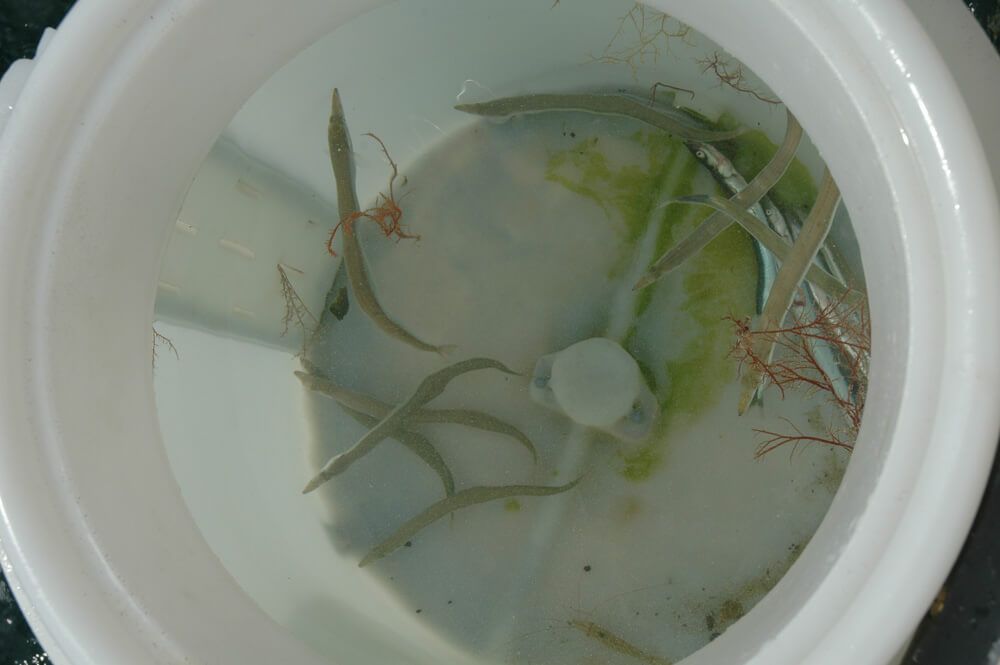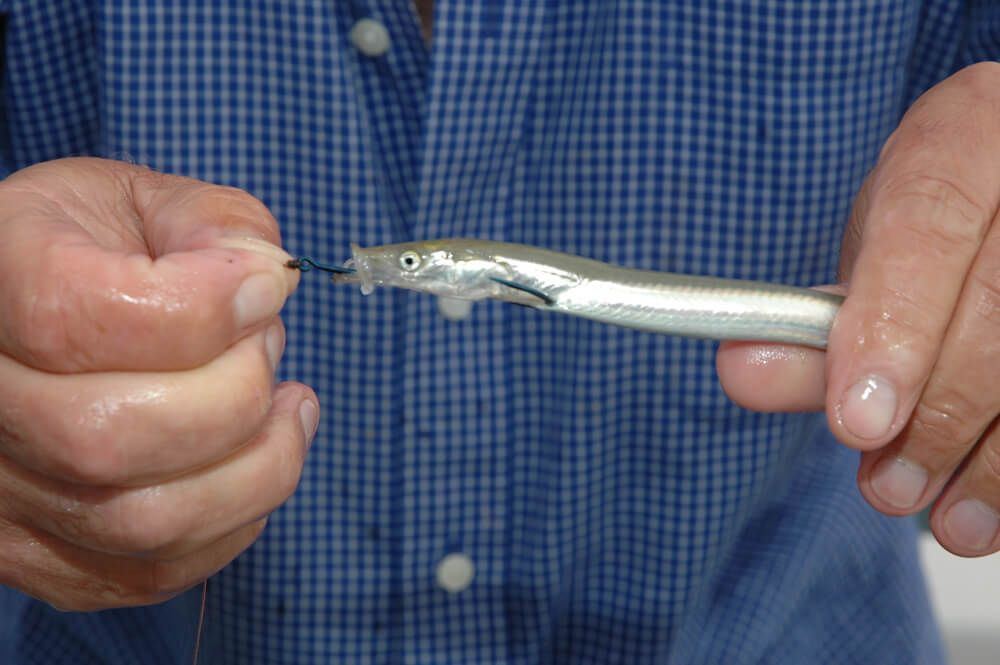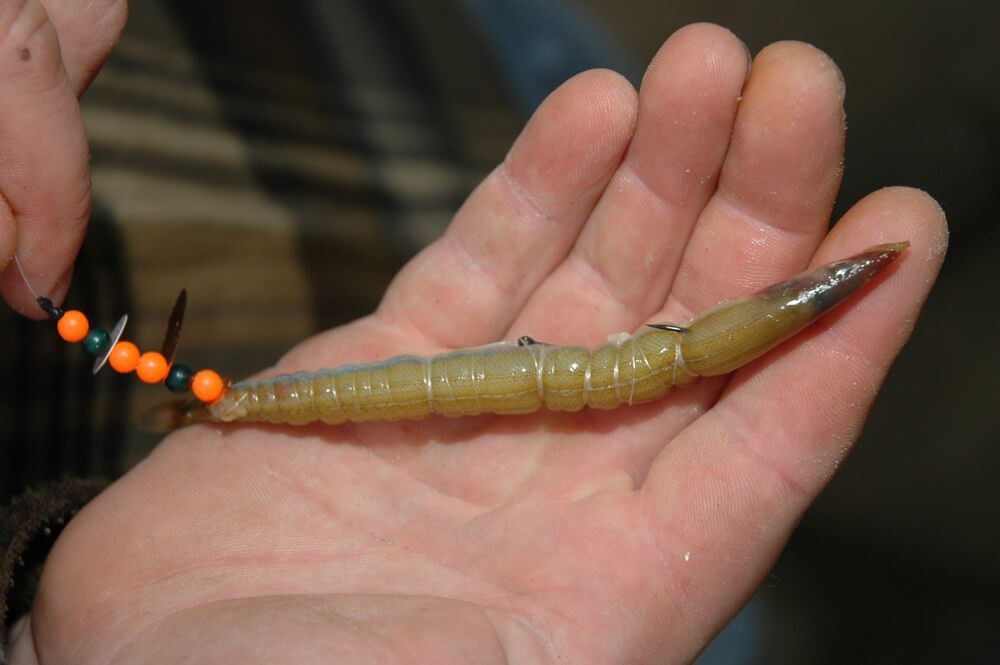A good all round bait for a multitude of species, best used as a deadly livebait for Bass.
TYPES
There are five varieties of sandeel indigenous to British waters....
Ammodytes tobianus - The most common inshore variety. Rarely exceeds 8ins in length.
Ammodytes marinus (Raitt's sandeel) - An offshore species preferring depths down to 175 metres, though can occur very close inshore around estuaries occasionally. Attains 10ins.
Gymnammodytes semisquamatus (Smooth sandeel) - Offshore species in depths up to 600ft. Maximum length 10ins.
Hyperoplus lanceolatus (Greater sandeel) - Common from low tide level to 200ft. Often referred to as "launce". Can reach a length of 15ins.
Hyperoplus immaculatus (Corbin's sandeel) - Another offshore variety living in depths between 100ft and 750ft. Grows to 12ins.
DISTRIBUTION
The first four varieties are all common right around the British Isles and Northern Europe as far as Iceland. Corbin's sandeel however, does not occupy the northern sector of the North Sea, nor the North European coastline, but is common on Atlantic coasts.
HABITAT
The inshore sandeels can be seen in tight dense shoals inside all the major, and minor, estuaries. They seek out the protection of pier supports, large mooring buoys, work the fringes of the mud flat creeks and drainage channels, and can be seen swimming close to weed beds and the edges of breakwaters and jetties.
Sandeels also frequent the low water tide line of shallow surf beaches and the numerous banks and gullies associated with the bar and outer mouth areas of estuaries. Bass are a chief predator of sandeels over such ground.
While they protect themselves by burying quickly into sandbanks and gravel, they are often found grouped together over mussel beds and patches of rough ground. This link with rough ground applies to the offshore species too. They shoal over high rising rocky pinnacles, and along the edges of deep drop-offs and shelves. Any shallow, or deep water reef will have it's resident sandeel populace predated on principally by bass and pollack.
The larger sandeels also favour the habitat provided by sunken wrecks, though they are generally in the mid water to upper reaches by day, dropping back to the seabed by night to bury into the sand. Heavy in roads are made into their numbers by pollack, coalfish and turbot close to the wrecks. Any high rising sandbanks laying far offshore is also sure to have it's resident populace of sandeels, and it's not uncommon to find bass feeding on them during the high summer period.

SEASON
Sandeels are mainly associated with summer fishing and do disappear from the estuary environment during late autumn, not returning until late April or early May. They don't go far though, they can be found along the shallow surf beaches, even in January and February when the sea is at it's coldest.
BREEDING
Inshore sandeels do not conform to one set time of year for breeding. Some areas sees a spring mate, whilst others witness an autumnal one. The offshore sandeels generally spawn from January to early April, though some continuance after this date is not unusual.
COLLECTION
Inshore sandeels are generally raked. This sees a small, thin curved laded tool known as a "Vingler" drawn through the upper layers of sand along the angled edges of inshore sandbanks.
The banks to try are those that sit next to pools of standing water. Sandeels prefer wet sand, not dry. Draw the "Vingler" repeatedly towards you in short strokes and about 3 to 4ins deep, no more. The blade cuts through the sand easily until a sandeel gets trapped in the curve. As this happens a definite resistance can be felt. Lift the blade upwards and be ready to grab the sandeel on sight as it emerges from the sand. Sandeels are ultra quick!
When inside estuaries it is possible to hook sandeels on float tackle using tiny size 18 hooks and minute pieces of mackerel flesh or worm. Another dodge is to tie a small bloody butcher trout fly on light line 8ins behind a silver spinner. The sandeel will then take the fly.
The larger offshore "Launce" will eagerly take mackerel feathers at times, though most get foul hooked. But, by substituting the feathers for much smaller ones on size 6 or 8 hooks, the sandeels can be legitimately hooked in the mouth. Small lengths of white or red silicone tubing can be used for the bodies, but silver is the best colour of all. Sometimes, they'll hit small undressed nickel plated hooks just as well!
Most anglers prefer to let somebody else worry about the collection of this superb bait and buy them from a shop both alive or frozen. More and more tackle shops are now offering live sandeels for sale.
STORAGE
Sandeels require constant oxygen and frequent changes of water. Shore anglers should keep live eels in a plastic bucket linked up to a small portable aerator. Try to have the aerator running constantly, and keep the eels cool and away from direct sunlight. When travelling, the constant shifting of the water inside the bucket may be enough to add sufficient oxygen without the aerator. Don't overcrowd the bucket, either! About a dozen average sized eels to a gallon of water is maximum. Keep checking for, and removing any dead ones.

On boats, you can use a "Courge". This is a woven, cylindrical basket or wooded box with small holes drilled through it that retains the eels, but allows water to pass through the weaving when the basket is submerged. There is also a similar plastic product called the Flow-Troll which is available from USA stores and occasionally from UK suppliers. This is the best storage system of all. Otherwise, stick with the bucket and aerator.
Frozen sandeels are excellent bait and often prove better than fresh dead ones. These need to be kept fully frozen during transit. Use a cool box with plenty of ice packs, or at worse wrap them frozen in multiple sheets of newspaper for insulation. Better still, especially for mobility, is a wide mouthed thermos flask. Sandeels will stay frozen for about 6 hours in one of these even during the heat of high summer.
PRESENTATION
For whiting, dabs, dogfish etc, cut small chunks straight through the body, or take strips from the flank of the sandeel. Small squares cut from a strip make a good tipping for worm baits and helps pick out the bigger whiting.
For bass, turbot and pollack, a live eel should be hooked once through the top lip, never through the wrist of the tail. The latter system sees too many bites missed. Use the same lip hook presentation when float fishing for pollack.

When ledgering frozen sandeel for rays and bass, choose a strong, but not too large pattern of Aberdeen hook. Kamasan's, or Sea Tec's are good. This should be passed in and out of the body with the shank and line repeatedly pulled through down the flank of the eel from the wrist of the tail towards the head. The actual hook point is always best positioned towards the head. Fish eat eels head first. Larger eels may require the same system, but with a pennel rig and the top hook being placed a little way down from the tail. A good wrap of thin elastic thread helps keep it all in place when power casting.

Large launce eels can be ledgered cut into sections about 4 to 6ins long. Mount these on 2/0 to 4/0 Mustad Viking hooks for huss etc.
WHAT SANDEEL CATCHES
From the shore, just about anything. Live sandeel is good for bass and flounders in estuaries. Frozen sandeel will take small eyed rays, spotted ray, occasionally thornbacks, bull huss, pollack and wrasse, but is especially good for dogfish and for sorting out the bigger whiting.
Offshore, sandeel is very effective over wrecks for pollack and Coalfish. Also over reefs for pollack, bass, codling, coalfish, rays and turbot. Over clean ground it takes turbot, huss, spotted ray and tope.
TIPS
When drifting for turbot in deep water, remove the backbone from a launce, but leave the fillets attached to the head as you would when preparing a mackerel flapper bait. A lip hook presentation gives natural movement and scent to the bait as it passes over the seabed.
When using live sandeel for bass and pollack, use only enough lead weight to get the eel down to the fish. The more lead you add, the less natural the eel will appear to the fish.
Always wear thick industrial gloves when raking, or collecting sandeels. Poisonous lesser weever fish adopt the same burying habit in the same ground.
TYPES
There are five varieties of sandeel indigenous to British waters....
Ammodytes tobianus - The most common inshore variety. Rarely exceeds 8ins in length.
Ammodytes marinus (Raitt's sandeel) - An offshore species preferring depths down to 175 metres, though can occur very close inshore around estuaries occasionally. Attains 10ins.
Gymnammodytes semisquamatus (Smooth sandeel) - Offshore species in depths up to 600ft. Maximum length 10ins.
Hyperoplus lanceolatus (Greater sandeel) - Common from low tide level to 200ft. Often referred to as "launce". Can reach a length of 15ins.
Hyperoplus immaculatus (Corbin's sandeel) - Another offshore variety living in depths between 100ft and 750ft. Grows to 12ins.
DISTRIBUTION
The first four varieties are all common right around the British Isles and Northern Europe as far as Iceland. Corbin's sandeel however, does not occupy the northern sector of the North Sea, nor the North European coastline, but is common on Atlantic coasts.
HABITAT
The inshore sandeels can be seen in tight dense shoals inside all the major, and minor, estuaries. They seek out the protection of pier supports, large mooring buoys, work the fringes of the mud flat creeks and drainage channels, and can be seen swimming close to weed beds and the edges of breakwaters and jetties.
Sandeels also frequent the low water tide line of shallow surf beaches and the numerous banks and gullies associated with the bar and outer mouth areas of estuaries. Bass are a chief predator of sandeels over such ground.
While they protect themselves by burying quickly into sandbanks and gravel, they are often found grouped together over mussel beds and patches of rough ground. This link with rough ground applies to the offshore species too. They shoal over high rising rocky pinnacles, and along the edges of deep drop-offs and shelves. Any shallow, or deep water reef will have it's resident sandeel populace predated on principally by bass and pollack.
The larger sandeels also favour the habitat provided by sunken wrecks, though they are generally in the mid water to upper reaches by day, dropping back to the seabed by night to bury into the sand. Heavy in roads are made into their numbers by pollack, coalfish and turbot close to the wrecks. Any high rising sandbanks laying far offshore is also sure to have it's resident populace of sandeels, and it's not uncommon to find bass feeding on them during the high summer period.

SEASON
Sandeels are mainly associated with summer fishing and do disappear from the estuary environment during late autumn, not returning until late April or early May. They don't go far though, they can be found along the shallow surf beaches, even in January and February when the sea is at it's coldest.
BREEDING
Inshore sandeels do not conform to one set time of year for breeding. Some areas sees a spring mate, whilst others witness an autumnal one. The offshore sandeels generally spawn from January to early April, though some continuance after this date is not unusual.
COLLECTION
Inshore sandeels are generally raked. This sees a small, thin curved laded tool known as a "Vingler" drawn through the upper layers of sand along the angled edges of inshore sandbanks.
The banks to try are those that sit next to pools of standing water. Sandeels prefer wet sand, not dry. Draw the "Vingler" repeatedly towards you in short strokes and about 3 to 4ins deep, no more. The blade cuts through the sand easily until a sandeel gets trapped in the curve. As this happens a definite resistance can be felt. Lift the blade upwards and be ready to grab the sandeel on sight as it emerges from the sand. Sandeels are ultra quick!
When inside estuaries it is possible to hook sandeels on float tackle using tiny size 18 hooks and minute pieces of mackerel flesh or worm. Another dodge is to tie a small bloody butcher trout fly on light line 8ins behind a silver spinner. The sandeel will then take the fly.
The larger offshore "Launce" will eagerly take mackerel feathers at times, though most get foul hooked. But, by substituting the feathers for much smaller ones on size 6 or 8 hooks, the sandeels can be legitimately hooked in the mouth. Small lengths of white or red silicone tubing can be used for the bodies, but silver is the best colour of all. Sometimes, they'll hit small undressed nickel plated hooks just as well!
Most anglers prefer to let somebody else worry about the collection of this superb bait and buy them from a shop both alive or frozen. More and more tackle shops are now offering live sandeels for sale.
STORAGE
Sandeels require constant oxygen and frequent changes of water. Shore anglers should keep live eels in a plastic bucket linked up to a small portable aerator. Try to have the aerator running constantly, and keep the eels cool and away from direct sunlight. When travelling, the constant shifting of the water inside the bucket may be enough to add sufficient oxygen without the aerator. Don't overcrowd the bucket, either! About a dozen average sized eels to a gallon of water is maximum. Keep checking for, and removing any dead ones.

On boats, you can use a "Courge". This is a woven, cylindrical basket or wooded box with small holes drilled through it that retains the eels, but allows water to pass through the weaving when the basket is submerged. There is also a similar plastic product called the Flow-Troll which is available from USA stores and occasionally from UK suppliers. This is the best storage system of all. Otherwise, stick with the bucket and aerator.
Frozen sandeels are excellent bait and often prove better than fresh dead ones. These need to be kept fully frozen during transit. Use a cool box with plenty of ice packs, or at worse wrap them frozen in multiple sheets of newspaper for insulation. Better still, especially for mobility, is a wide mouthed thermos flask. Sandeels will stay frozen for about 6 hours in one of these even during the heat of high summer.
PRESENTATION
For whiting, dabs, dogfish etc, cut small chunks straight through the body, or take strips from the flank of the sandeel. Small squares cut from a strip make a good tipping for worm baits and helps pick out the bigger whiting.
For bass, turbot and pollack, a live eel should be hooked once through the top lip, never through the wrist of the tail. The latter system sees too many bites missed. Use the same lip hook presentation when float fishing for pollack.

When ledgering frozen sandeel for rays and bass, choose a strong, but not too large pattern of Aberdeen hook. Kamasan's, or Sea Tec's are good. This should be passed in and out of the body with the shank and line repeatedly pulled through down the flank of the eel from the wrist of the tail towards the head. The actual hook point is always best positioned towards the head. Fish eat eels head first. Larger eels may require the same system, but with a pennel rig and the top hook being placed a little way down from the tail. A good wrap of thin elastic thread helps keep it all in place when power casting.

Large launce eels can be ledgered cut into sections about 4 to 6ins long. Mount these on 2/0 to 4/0 Mustad Viking hooks for huss etc.
WHAT SANDEEL CATCHES
From the shore, just about anything. Live sandeel is good for bass and flounders in estuaries. Frozen sandeel will take small eyed rays, spotted ray, occasionally thornbacks, bull huss, pollack and wrasse, but is especially good for dogfish and for sorting out the bigger whiting.
Offshore, sandeel is very effective over wrecks for pollack and Coalfish. Also over reefs for pollack, bass, codling, coalfish, rays and turbot. Over clean ground it takes turbot, huss, spotted ray and tope.
TIPS
When drifting for turbot in deep water, remove the backbone from a launce, but leave the fillets attached to the head as you would when preparing a mackerel flapper bait. A lip hook presentation gives natural movement and scent to the bait as it passes over the seabed.
When using live sandeel for bass and pollack, use only enough lead weight to get the eel down to the fish. The more lead you add, the less natural the eel will appear to the fish.
Always wear thick industrial gloves when raking, or collecting sandeels. Poisonous lesser weever fish adopt the same burying habit in the same ground.

